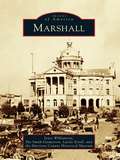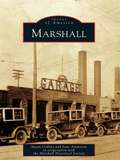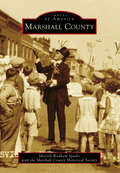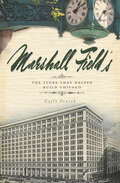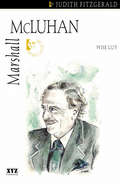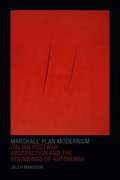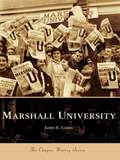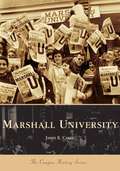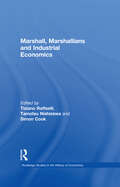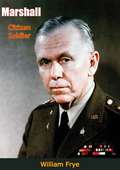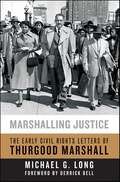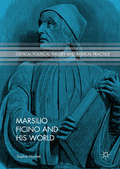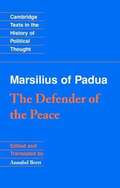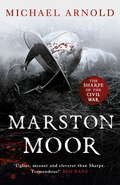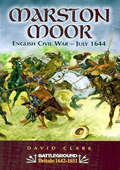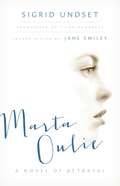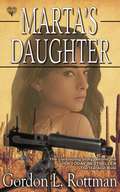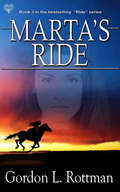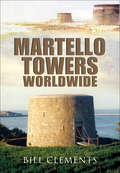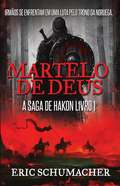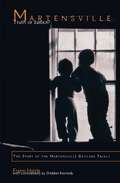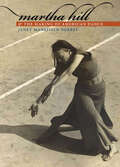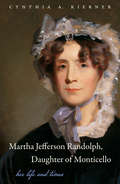- Table View
- List View
Marshall
by Pat Smith-Gasperson Harrison County Museum Lucile Estell Joyce WilliamsonNestled among towering pine trees in East Texas is the city of Marshall. Marshall is closely identified with Caddo Lake, a massive body of water located northeast of the town. According to the Caddo Indians who first inhabited this land, the mysterious lake was formed overnight from an earthquake. Spanish and French explorers sought to claim the land as their own in the 16th century, and American settlers arrived here in about 1830. The city of Marshall was founded in 1842, eventually becoming the county seat of Harrison County. With the arrival of the Texas and Pacific Railroad after the Civil War, Marshall became known as the "Gateway to Texas," and the town prospered. Today education plays an important role in the local economy, and Marshall is the home of Wiley College, East Texas Baptist University, and Texas State Technical Institute. Life in Marshall continues to revolve around the town square, with the majestic, restored courthouse at its center.
Marshall
by Jane Ammeson Susan Collins Marshall Historical SocietyA charming Michigan town and recipient of the Dozen Distinctive Destinations award by the National Trust for Historic Preservation, Marshall boasts homes and businesses that are immaculately restored architectural gems whose styles include Gothic Revival, Queen Anne, and Second Empire. To stroll along the streets here, past the Honolulu House, home to the Marshall Historical Society and a paean to a 19th-century judge's passion for the tropics, toward the National House, an old stagecoach inn dating back to the 1840s and now a thriving bed-and-breakfast, is to appreciate the homage to the past that has kept this jewel of a town a major travel destination for those who honor history. History comes alive to those dining at Winn Schuler's, the oldest restaurant in the state and a mainstay in downtown Marshall since the beginning of the 20th century. In Marshall, it is easy to step back in time and enjoy all that life had to offer to travelers of a different era.
Marshall County
by Marshall County Historical Society Sherrill Wadham SparksThe Oregon-California Trail carried more than 100,000 settlers west over the prairies of the future state of Kansas in the mid-1800s. Pioneers and Pony Express riders crossed the Big Blue River at Independence Crossing or at Frank Marshall's ferry near present-day Marysville. In 1846, members of the Donner Party discovered and named Alcove Spring, now one of 20 county sites listed in the National Register of Historic Places. The Kansas Territorial Legislature established Marshall County in 1855. After the Civil War, rich soil and abundant water attracted farmers, and its location attracted railroads and industry. Today, the same occupations still sustain the 16 towns and villages. As the "Gateway to the Flint Hills," the county's rolling hills are dotted with picturesque prairie, woods, limestone outcrops, rivers, and creeks. Even though the county is a crossroads for modern highways US 36 and US 77, pioneer wagon ruts are still visible in Marshall County.
Marshall Field's: The Store that Helped Build Chicago (Landmarks)
by Gayle SoucekA history of the iconic department store and a city&’s life over a century and a half.Anyone who has waited in a Christmas line for the Walnut Room&’s Great Tree can attest that Chicago&’s loyalty to Marshall Field&’s is fierce. Dayton-Hudson even had to take out advertising around town to apologize for changing the Field's hallowed green bags. And with good reason—the store and those who ran it shaped the city's streets, subsidized its culture, and heralded its progress. The resulting commercial empire dictated wholesale trade terms in Calcutta and sponsored towns in North Carolina, but its essence was always Chicago. So when the Marshall Field name was retired in 2006 after the stores were purchased by Macy&’s, protest slogans like &“Field&’s is Chicago&” and &“Field&’s: as Chicago as it gets&” weren't just emotional hype. Many still hope that name will be resurrected like the city it helped support during the Great Fire and the Great Depression. Until then, fans of Marshall Field&’s can celebrate its history with this warm look back at the beloved institution.</
Marshall McLuhan
by Judith FitzgeraldCommunications theorist Marshall McLuhan (1911-1980) predicted the effects of electronic media on modern culture as early as 1964. McLuhan published several breakthrough books and coined terms like "hot" and "cool" media, "the global village," and "the medium is the message."
Marshall Plan Days (Routledge Revivals)
by Charles P. KindlebergerOriginally published in 1987 to commemorate the 40th anniversary of the Marshall Plan, this fascinating collection of essays, from an eminent ‘insider’ to the Marshall Plan, combines economics, politics and history to provide authoritative and personal insights into the creation of one of the greatest foreign aid programmes of the twentieth century. Any reader interested in the Marshall Plan itself, the inner workings of a major act of US foreign policy, and its many economic, political and historical facets will welcome the reissue of this valuable book from one of America’s most distinguished economists.
Marshall Plan Modernism: Italian Postwar Abstraction and the Beginnings of Autonomia
by Jaleh MansoorFocusing on artwork by Lucio Fontana, Alberto Burri, and Piero Manzoni, Jaleh Mansoor demonstrates and reveals how abstract painting, especially the monochrome, broke with fascist-associated futurism and functioned as an index of social transition in postwar Italy. Mansoor refuses to read the singularly striking formal and procedural violence of Fontana's slit canvasses, Burri's burnt and exploded plastics, and Manzoni's "achromes" as metaphors of traumatic memories of World War II. Rather, she locates the motivation for this violence in the history of the medium of painting and in the economic history of postwar Italy. Reconfiguring the relationship between politics and aesthetics, Mansoor illuminates how the monochrome's reemergence reflected Fontana, Burri, and Manzoni's aesthetic and political critique of the Marshall Plan's economic warfare and growing American hegemony. It also anticipated the struggles in Italy's factories, classrooms, and streets that gave rise to Autonomia in the 1960s. Marshall Plan Modernism refigures our understanding of modernist painting as a project about labor and the geopolitics of postwar reconstruction during the Italian Miracle.
Marshall University (Campus History)
by James E. CastoIn 1837, the people of Guyandotte, then a village on the Virginia frontier, resolved to open a school for their sons and daughters. Tradition says local lawyer John Laidley convinced his neighbors to name the school for his friend, Chief Justice John Marshall. The one-room log cabin that housed those first students soon gave way to a two-story brick building that, with various additions over the years, became the school's Old Main. For decades, the cherished landmark has stood like a proud sentinel, watching Marshall grow and evolve into a major university with an enrollment over 16,000. This remarkable volume, with more than 200 historic photographs from the Marshall archives, chronicles the dramatic Marshall saga.
Marshall University (The Campus History Series)
by James E. CastoIn 1837, the people of Guyandotte, then a village on the Virginia frontier, resolved to open a school for their sons and daughters. Tradition says local lawyer John Laidley convinced his neighbors to name the school for his friend, Chief Justice John Marshall. The one-room log cabin that housed those first students soon gave way to a two-story brick building that, with various additions over the years, became the school's Old Main. For decades, the cherished landmark has stood like a proud sentinel, watching Marshall grow and evolve into a major university with an enrollment over 16,000. This remarkable volume, with more than 200 historic photographs from the Marshall archives, chronicles the dramatic Marshall saga.
Marshall, Marshallians and Industrial Economics (Routledge Studies In The History Of Economics Ser.)
by Tiziano Raffaelli Tamotsu Nishizawa Simon CookThe four sections of the book deal in succession with Marshall’s key ideas on the subject, the wider context of his thought in which they are to be read, their later development by some of his pupils, and their revival in contemporary economics. The first and last sections work together to illustrate the evolutionary focus of Marshall’s research program and to identify its affinity with modern industrial economics; the second explicates the social assumptions within which the Marshallian paradigm was embedded, in particular those relating to the various relationships that exist between individuals and wider groups; while the third traces the development of Marshall’s views by some of his pupils.
Marshall: Citizen Soldier
by William FryeIf you think of biography as the static record of a man’s achievement, compiled during twenty or more mellowing years, William Frye’s book will have the impact of an electric shock. Marshall: Citizen Soldier is not to be leafed through idly, just as George Catlett Marshall himself cannot be regarded passively.That deceptively mild manner of his, as buck privates, brass hats and not a few politicos have discovered, only indifferently conceals a driving determination, backed by an inner steel core of moral integrity and joined with a lifetime’s habit of command.The general public has not given Marshall the excited, short-lived adulation that it has heaped upon more flamboyantly dramatic military men. But the people recognized in George Marshall the citizen’s soldier to whom they could safely entrust the most vital post in an America at war—Chief of Staff of the United States Army.The acceptance by Marshall early in 1947 of one of the greatest appointive offices in our government, that of Secretary of State, a job today of world significance, leaves no doubt either of the abilities of the man or of his devotion to the public weal. For the dearest wish of the erstwhile Chief of Staff had been a quiet retirement at the end of his Army duties.Marshall began his career in unorthodox fashion by graduating from the V.M.I. instead of West Point. Even on routine tours of duty in the Philippines, in the States and later in China he was singled out by senior officers as a young man of remarkable ability. During World War I, Marshall asked for command duty in France. His superiors rushed him abroad but they realized that Major Marshall was hard-to-get staff officer material, not slated for a regular front-line assignment.William Frye as Marshall’s biographer comes into touch with some of the knottiest questions of the war years. He does not sidestep issues and controversies; he meets them with decision.
Marshalling Justice: The Early Civil Rights Letters of Thurgood Marshall
by Michael G. Long“[An] important collection….Michael G. Long deserves high praise indeed for unearthing [Marshall’s letters] and bringing them to light.”—Wil HaygoodCollected together for the first time in Marshalling Justice, here are selected letters written by one of the most influential and important activists in the American Civil Rights movement: the brilliant legal mind and footsoldier for justice and racial equality, Thurgood Marshall. The correspondences of a rebellious young attorney with the National Association for the Advancement of Colored People (NAACP), Marshalling Justice paints an eye-opening portrait of Thurgood Marshall before he became the first African American to serve on the U.S. Supreme Court, during his years as a groundbreaking and vibrant Civil Rights activist in the tradition of Martin Luther King and Julian Bond.
Marsilio Ficino and His World
by Sophia HowlettThis book makes the case for Marsilio Ficino, a Renaissance philosopher and priest, as a canonical thinker, and provides an introduction for a broad audience. Sophia Howlett examines him as part of the milieu of Renaissance Florence, part of a history of Platonic philosophy, and as a key figure in the ongoing crisis between classical revivalism and Christian belief. The author discusses Ficino's vision of a Platonic Christian universe with multiple worlds inhabited by angels, daemons and pagan gods, as well as our own distinctive role within that universe - climbing the heights to talk with angels yet constantly confused by the evidence of our own senses. Ficino as the "new Socrates" suggests to us that by changing ourselves, we can change our world.
Marsilius of Padua at the Intersection of Ancient and Medieval Traditions of Political Thought
by Vaileios SyrosThis book focuses on the reception of classical political ideas in the political thought of the fourteenth-century Italian writer Marsilius of Padua. Vasileios Syros provides a novel cross-cultural perspective on Marsilius's theory and breaks fresh ground by exploring linkages between his ideas and the medieval Muslim, Jewish, and Byzantine traditions.Syros investigates Marsilius's application of medical metaphors in his discussion of the causes of civil strife and the desirable political organization. He also demonstrates how Marsilius's demarcation between ethics and politics and his use of examples from Greek mythology foreshadow early modern political debates (involving such prominent political authors as Niccolò Machiavelli and Paolo Sarpi) about the political dimension of religion, church-state relations, and the emergence and decline of the state.
Marsilius of Padua: The Defender of the Peace
by Annabel Brett'The Defender of the Peace of Marsilius of Padua' is a massively influential text in the history of western political thought. Marsilius offers a detailed analysis and explanation of human political communities, before going on to attack what he sees as the obstacles to peaceful human coexistence.
Marston Moor: Book 6 of The Civil War Chronicles (Stryker)
by Michael ArnoldThe Sixth in The Civil War Chronicles featuring Major Stryker - 'the Sharpe of the Civil War'FIVE ARMIES FORTY-SIX THOUSAND MEN ONE CROWNTHE BIGGEST BATTLE OF THE AGE2 July 1644. Five armies converge outside York. It will be a battle for honour, glory, and the fate of three kingdoms. And it will pit two great leaders - Oliver Cromwell and Prince Rupert - directly against one another for the first time. It is a day that will change the course of history.Into the cannon fire and musket smoke marches Major Innocent Stryker, battle-scarred hero of the Royalist cause. He must not only lead his men through the bloody horror and outwit his Parliamentary enemies, but uncover foul treachery on his own side. He will need every shred of experience and determination to survive.Marston Moor will be the decisive turning point in the British Civil Wars.This is the thrilling and shocking story of that battle.
Marston Moor: English Civil War–July 1644 (Battleground Britain 1642–1651)
by David ClarkFollowing on from the success of the first book in this series on the English Civil war, Naseby, here is the story of Marston Moor, arguably the most famous battle in the four year conflict.In this exciting analysis of the battle the Author has captured the atmosphere and made it possible to get the most out of the experience. Marston Moor was an extremely bitter and costly battle and a defeat for the Royalist cause that had major implications for King Charles I. One result was that the key city of York was lost thereby seriously weakening the King's grip on the North.
Marta Oulie: A Novel of Betrayal
by Sigrid Undset&“I have been unfaithful to my husband.&” Marta Oulie&’s opening line scandalized Norwegian readers in 1907. And yet, Sigrid Undset had a gift for depicting modern women &“sympathetically but with merciless truthfulness,&” as the Swedish Academy noted in awarding her the Nobel Prize for Literature in 1928. At the time she was one of the youngest recipients and only the third woman so honored. It was Undset&’s honest story of a young woman&’s love life—&“the immoral kind,&” as she herself bluntly put it—that made her first novel an instant sensation in Norway.Marta Oulie, written in the form of a diary, intimately documents the inner life of a young woman disappointed and constrained by the conventions of marriage as she longs for an all-consuming passion. Set in Kristiania (now Oslo) at the beginning of the twentieth century, Undset&’s book is an incomparable psychological portrait of a woman whose destiny is defined by the changing mores of her day—as she descends, inevitably, into an ever-darker reckoning. Remarkably, though Undset&’s other works have attracted generations of readers, Marta Oulie has never before appeared in English translation. Tiina Nunnally, whose award-winning translation of Undset&’s Kristin Lavransdatter captured the author&’s beautifully clear style, conveys the voice of Marta Oulie with all the stark poignancy of the original Norwegian.
Marta's Daughter (Ride #4)
by Gordon L. RottmanArsenia Renee Eugen is the seventeen-year-old daughter of the living legends, Bud and Marta Eugen. While ranch-raised and as capable as any vaquero, she was educated at the St. Joseph Academy in Eagle Pass, Texas. She holds down a dull job as a bookkeeper and assistant manager of the Flint Hotel. Shopping in Piedras Negras across the Rio Grande she was conned by twenty-one-year-old Yaqui Ana Mendoza Gomez. Swearing vengeance, she sought out the young woman and unexpectedly rescued her from gringos bent on revenge after Yaqui Ana had conned them. Not expecting to see Yaqui Ana again, Arsenia received a note that the woman had been forced into prostitution. Again rescuing her, they find themselves taking over a notorious cantina and cathouse, where they fall into a world of gamblers, drinkers, conmen, smugglers, gun runners, banditos, treacherous militiamen, spies, and traitors.
Marta's Ride (Ride #3)
by Gordon L. RottmanA USA TODAY and Amazon bestseller, author Gordon L. Rottman has finally given fans of The Hardest Ride and Ride Harder their beloved heroine Marta’s own tale, and in a way, her own voice. The brutal 1886 winter on the Texas-Mexico border is a terrible time for a mute sixteen-year-old Mexican girl and her familia, who roam the trails and towns of the frontier, searching for work and struggling to survive. When her parents and siblings are murdered before her eyes, Marta is faced with a stark reality. Completely alone in the harsh Texas backlands, she realizes her own time in this world will be short, lonely, and possibly end in blood. Marta has not lived and thrived in her hardscrabble life thus far to give up without a fight. And the arrival of an out of work cowboy from whom she grudgingly accepts help and protection gives her a sliver of hope. Besides she reasons, Güero—Blondie—as she’s named him, would be lost without her care, guidance, and decent meals. Despite the chasm between Mexicans and Anglos in this harsh age, the loner cowpoke and mute Mexican girl tentatively build a fragile trust. Finding work on a welcoming ranch, the couple bonds, and their future appears brighter. But a raid by vicious bandits takes Marta, another Mexican girl, and the rancher’s two daughters on a journey into hell. Marta tells us a harrowing tale of terror and anguish as the women struggle to stay alive and hang on to their sanity. Her faith in Güero coming to their rescue rises and diminishes day-to-day as their circumstances change. In the end, there is a great deal more to Marta than we ever realized.
Martello Towers Worldwide
by Bill ClementsMartello Towers Worldwide follows the history of the Martello tower from the construction of the early towers built to protect the Mediterranean shores of Spain and Italy right up to the final towers built in the United Kingdom during the First World War.The book is illustrated with a large number of contemporary and historic photographs, drawings and plans, a very large number of which were not included in the earlier Towers of Strength. These provide the most detailed information yet published about the development of the Martello towers in Britain and overseas. So the book will be of particular interest to those interested in the history of fortifications, architectural conservation and military history generally. It will also be of interest to an international readership as the book now has a gazetteer of towers outside the United Kingdom that remain today together with a chapter describing a number of towers built in the United States.The book supplements the earlier Towers of Strength and such will be an important addition to the existing bibliography of books on Martello towers and fortification.
Martelo de Deus
by Eric SchumacherA história e a lenda se confundem no emocionante conto sobre a vida de Hakon Haraldsson, um menino cristão que lutou pelo Alto Assento de um reino viking. Estamos no ano de 935 d.C. e o norte vives um tempo tumultuado. O rei Harald Fairhair morreu, deixando o Alto Assento do seu reino para o seu filho assassino, Erik Bloodaxe. Para garantir a sua ascensão, Erik impiedosamente elimina todos os pretendentes ao seu trono, exceto um: o seu irmão mais novo, Hakon. Os inimigos sobreviventes de Erik enviam um navio para Wessex, onde o rei cristão Athelstan está criando Hakon. Incapaz de fugir de seu destino, Hakon retorna ao Norte Viking para enfrentar o seu irmão e reivindicar o seu direito de primogenitura, mas ele vai descobrir que a vitória exigirá sacrifícios além de seus pesadelos mais selvagens.
Martensville: The Story of the Martensville Daycare Trials
by Frann HarrisWhen a child-abuse scandal is uncovered at an unlicenced daycare in small-town Saskatchewan, it polarizes the community. Frann Harris, a rookie court reporter assigned to the trial the longest in Saskatchewan history starts to wonder if the scope of the alleged crimes is dwarfed by something even more startling: a botched police investigation and inappropriate courtroom procedures.Harris’ narrative alternates between the stories of child sexual abuse and whimsical recollections of her own childhood, using the odd touch of humour. Because the unfamiliar courtroom jargon sounds like a foreign language to her and to most readers, she translates it into plain English, and simplifies and demystifies elaborate and stylized courtroom procedures.Harris takes the reader into the courtroom, recreating the trial in all its complexities: the painful allegations of the children and their parents; the daily parry-and-thrust of lawyers trying to discredit both the police investigation and the testimony of the victims; and the contradictory testimony of psychologists and medical experts. Harris also goes outside the courtroom, interviewing witnesses and eavesdropping on the conversations of the accused, the police, neighbours and journalists.The verdicts in the Martensville case were and still are hotly contested. We may never know what really happened at the daycare, but in Martensville: Truth or Justice? The Story of the Martensville Daycare Trials, we can learn the intricacies of the investigation and the trial, and decide for ourselves whether justice was served.
Martha Hill and the Making of American Dance
by Janet Mansfield SoaresA lively and intimate portrait of an unsung heroine in American dance Martha Hill (1900–1995) was one of the most influential figures of twentieth century American dance. Her vision and leadership helped to establish dance as a serious area of study at the university level and solidify its position as a legitimate art form. Setting Hill's story in the context of American postwar culture and women's changing status, this riveting biography shows us how Hill led her colleagues in the development of American contemporary dance from the Kellogg School of Physical Education to Bennington College and the American Dance Festival to the Juilliard School at Lincoln Center. She created pivotal opportunities for Martha Graham, Doris Humphrey, Charles Weidman, Hanya Holm, José Limón, Merce Cunningham, and many others. The book provides an intimate look at the struggles and achievements of a woman dedicated to taking dance out of the college gymnasium and into the theatre, drawing on primary sources that were previously unavailable. It is lavishly illustrated with period photographs.
Martha Jefferson Randolph, Daughter of Monticello
by Cynthia A. KiernerAs the oldest and favorite daughter of Thomas Jefferson, Martha "Patsy" Jefferson Randolph (1772-1836) was extremely well educated, traveled in the circles of presidents and aristocrats, and was known on two continents for her particular grace and sincerity. Yet, as mistress of a large household, she was not spared the tedium, frustration, and great sorrow that most women of her time faced. Though Patsy's name is familiar because of her famous father, Cynthia Kierner is the first historian to place Patsy at the center of her own story, taking readers into the largely ignored private spaces of the founding era. Randolph's life story reveals the privileges and limits of celebrity and shows that women were able to venture beyond their domestic roles in surprising ways.Following her mother's death, Patsy lived in Paris with her father and later served as hostess at the President's House and at Monticello. Her marriage to Thomas Mann Randolph, a member of Congress and governor of Virginia, was often troubled. She and her eleven children lived mostly at Monticello, greeting famous guests and debating issues ranging from a woman's place to slavery, religion, and democracy. And later, after her family's financial ruin, Patsy became a fixture in Washington society during Andrew Jackson's presidency. In this extraordinary biography, Kierner offers a unique look at American history from the perspective of this intelligent, tactfully assertive woman.
